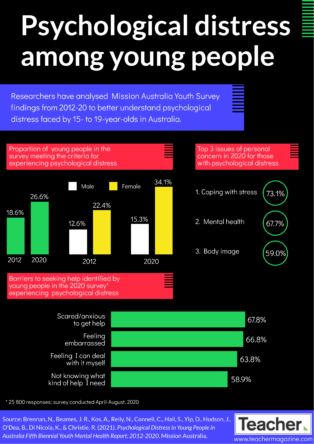Understanding the issues students in your school community are most concerned about can help inform relevant school policies and support programs. One way of staying informed is by referring to data at a school, local, or national level.
The most recent findings from Mission Australia’s Annual Youth Survey found that the top three concerns for young people aged 15-19 are coping with stress, mental health, and school and study problems. The survey received responses from over 20 000 young people across the country. The data also show young people believe the most important issues in Australia currently are COVID-19, the environment, and equity and discrimination.
The majority of survey respondents shared that they are mostly happy with their lives and optimistic about the future, however it was also clear that female and gender diverse young people were more likely to hold concerns about the issues of stress, mental health, and school problems than males. And, Aboriginal and Torres Strait Islander young people were less likely than non-Indigenous people to report being happy with their lives, and much more likely to say they have been treated unfairly.
The survey findings are presented in a report, and in today’s Q&A article, two of the report’s co-authors – Impact Measurement and Evaluation Officer, Eboni Tiller, and Senior Policy Officer, Andrew Kos – join Teacher to share how young peoples’ concerns have changed over time, and how educators can use this data to support their students
The 2021 Youth Survey report shows the most important issues for students last year were COVID-19, the environment, and equity and discrimination. In the past few years, how have the issues of concern of students been shifting? What has stayed the same?
Eboni Tiller: In the past few years we have seen the environment and equity and discrimination increase as important national issues for young people in Australia. It is likely not a coincidence their rise has coincided with School Strike for Climate Change, Black Lives Matter and the Me Too movement. It demonstrates just how engaged young people are in political and societal issues.
On the other hand, mental health has been in the top concerns for young people since at least 2016. Throughout the Youth Survey we see over and over how mental health is impacting young people, and we know this has been exacerbated by COVID-19 and the related restrictions.
Young people bring to bear valuable perspectives and it is crucial we listen. These issues have very real and tangible impacts and we have seen in some of the responses that young people don’t believe there is enough being done about them.
There are some issues that have been raised consistently by young people in your survey year on year, but other issues have risen in importance quite significantly in recent years. What do these changes in issues of concern indicate? Is this why it is important for you to conduct this survey yearly?
ET: The changes indicate that, despite some common misconceptions, this generation of young people are interested and engaged in issues that affect them and those around them. The rise in concern about the environment and climate change is a key example. As we have seen these concerns grow, we update the survey to provide opportunities to capture how these issues are impacting young people.
The annual nature of the Youth Survey allows us to be responsive to these emerging trends. Obviously, COVID-19 has appeared as a major concern over the last two years, and through the survey we have been able to capture some important data about how COVID-19 has impacted and continues to impact young people and their lives.
The yearly collection of data also allows us to target specific areas important to young people and take a deep dive into topical issues. In 2021, we produced additional reports highlighting the circumstances and needs of young people who are economically disadvantaged (PDF, 4.5KB) or experiencing psychological distress (PDF, 3.7KB), as well as young people’s experience of COVID-19 (PDF, 8.5KB).
For educators wanting to support their students in these areas, how can they go about doing this? What are some good first steps to take?
Andrew Kos: Helping to create a school environment that is safe, supportive and empowers students to speak and be heard is an important starting point. This is particularly the case for issues such as mental health, discrimination and unfair treatment which can be highly influenced by the school environment. We also know that these issues are felt and experienced more deeply by certain groups of students. For example, gender diverse students who don’t have a supportive and inclusive environment are more at risk of experiencing abuse and poor educational outcomes.
Many educators would know and practice this, but positive role modelling, calling out and responding to bullying and being open and empathetic to all students, are some of the practical ways they can contribute to a safe and supportive environment. Working closely with the school counsellor and accessing evidence-based online resources will help equip educators with additional knowledge and skills to respond to vulnerable students in their care. While educators cannot solve every problem alone, they are often the first to know or suspect something is wrong. That’s why it is important they are backed by a whole-of-school approach that puts student health and wellbeing at the forefront.
More broadly, how can educators working in classrooms use the information in your annual reports to inform their planning for student wellbeing?
ET: The Youth Survey provides a wealth of information about how young people are thinking and feeling and the issues that are concerning them. It can be used by educators to engage with young people and delve into what types of support they may appreciate and benefit from. We would encourage educators to take the Youth Survey results directly to their students or student leaders as a conversation starter. Ask them questions like, ‘Is this true for you?’ and ‘What can we do to address this?’
Unfortunately, the data show that in many ways young people are struggling. The past two years have been challenging for many and COVID-19 disruptions have impacted many areas in young people’s lives. The survey hears from adolescents aged 15-19 at an important transition when they are evaluating their future and beginning to consider what post-school life may involve.
Over the past 10 years there has been a declining trend in how positive young people feel about the future. In 2012, 70.6 per cent of young people felt ‘very positive’ or ‘positive’ about the future. By 2021, this had declined to 51.6 per cent. Young people will likely benefit from open discussion about their future options, the current barriers they are facing and what support they might need.
Mission Australia partners closely with many schools across Australia to deliver the Youth Survey, and for schools that are able to get 100 or more responses we provide a report back with their data. These reports help schools identify and target specific areas relevant to their students and have been greatly appreciated and valued by many in the development of their wellbeing programs. Please get in touch with us if you’d like to explore this option for your school.
Are there any particular areas of concern students have raised that the school environment can play a key part in addressing and supporting?
AK: Many of the concerns raised by students span their personal, school and work lives and speak to the need for holistic action around young people’s health and wellbeing. Coping with stress, mental health and school or study problems are consistently reported as top concerning issues. This year we also found a significant number of young people’s exercise, screen and sleep habits are outside of the Australian physical activity and exercise guidelines.
Schools are important places for identifying and providing support as most children and young people attend school. Most state governments have student wellbeing frameworks in place that can provide a foundation for this work, but locally developed student wellbeing strategies are an additional way to organise and direct effort. This of course creates additional work and responsibilities, and schools should be adequately funded and resourced with appropriate staff to carry out this work effectively.
Anything else you’d like to mention?
AK: Each year the survey findings remind us of the diversity of young people and the importance of hearing what they have to say. But it should not stop there. Young people also need to be at the centre of developing the solutions to the issues they raise.
ET: The Youth Survey is only possible due to the relationships we have with schools. We invite anyone interested in participating in the 2022 Youth Survey to contact us and register your interest at missionaustralia.com.au/youthsurvey
References
Tiller, E., Greenland, N., Christie, R., Kos, A., Brennan, N., & Di Nicola, K. (2021). Youth Survey Report 2021. Mission Australia. https://www.missionaustralia.com.au/publications/youth-survey
Think about the last time you reviewed the programs you have in place to support student welfare. What evidence did you use to inform the effectiveness of these programs? How involved were students in the process?
Andrew Kos says positive role modelling, calling out and responding to bullying and being open and empathetic to all students, are some of the practical ways teachers can contribute to a safe and supportive environment. As an educator, reflect on these strategies. Can you think of an example in the classroom where you’ve utilised one?



